|
|
|
impressive, but in poor taste
Sunday, July 28 2019
location: Room 5115, cruise ship Vasco da Gama in the port of St. Petersburg, Russia
Gretchen and I had to get up even earlier to begin our second day of the comprehensive tour of St. Petersburg, and this time we dressed for the warm conditions (and laxer dress codes). (A few days ago someone had told us that Russian churches abhor bare skin and that our legs should be covered, but then it turned out that all the churches we'd be visiting were actually museums where such rules don't apply.) The events desk on the Vasco da Gama had never opened, so we had the same problem with a lack tickets as we'd had yesterday. But this time we knew it didn't really matter. On today's tour, we spent more time just driving to places, which gave me the mental downtime I'd been missing yesterday.
Our first destination was the Catherine Palace in the town of Pushkin, which is due south of St. Petersburg. It's a massive palace with the grandeur and scale of Versailles. We arrived before it had opened, and while the crowd of tourists gathered, some gentleman in 19th Century military garb played music (mostly using voice and wind instruments) for tips. Strangely, the grounds seemed to have the faint odor of dog shit, causing me check the bottom of my flip flops at least once.
Once we'd passed through the gates, the palace looked to be in immaculate condition, though the ornamental statuary on the façade had been painted in tan paint instead of gilded as a cost-saving measure (to gild them would require hundreds of pounds of gold). The interior was as lavish as the exterior promised, with lots of gilt detailing, statuary, paintings, and meticulously-painted walls, often with color palettes changing from one room to the next. There was also a room decorated mostly with Baltic Sea amber, though this was just a reproduction. The Nazis (who had occupied the palace while unsuccessfully laying siege to Leningrad) had broken down the amber room and shipped it back to Germany (where it remains lost) just before retreating. They'd also set fire to most of the palace, leaving much of it in ruins (there were black and white pictures showing the devastation).
Perhaps more remarkable than the existence of the palace itself was the fact that it had been so quickly and perfectly restored by the Soviets after the Nazi defeat. This is interesting for two reasons. Firstly, the palace represents everything that the Soviets were not: elitist hereditary rulers who were able to build such opulence (much like those at the peak of a multi-level marketing scam) on the backs of a vast and poor majority. Secondly, rebuilding such a palace requires very particular talents in great quantities. Such talent would be prohibitively expensive in the west, where lost artifacts from history are, at best, commemorated by an informative sign or, perhaps more often, completely forgotten and replaced with something ugly and modern. Evidently the Soviet model, while it may not be particularly efficient at distributing products to consumers, is highly effective at fixing things that have been broken. If you're a master wood inlayer and Stalin's boys tell you that you have to spend the next six years fixing floors at some palace that the Nazis have destroyed, you say "да товарищ!" and clear your calendar. This also accounts for the stunning (and unexpected) beauty of downtown Gdansk.
None of this is to say that the Catherine Palace is in particularly good taste. The over-the-top rococo and excessive use of gold looks less like something one would expect from a nation's hereditary rulers than the profligate thrashings of a hillbilly who just won the Powerball. Gretchen paid closer attention to our guide Irena than I did and learned that the tacky opulence was mostly the work of the Empress Elizabeth, who didn't like the more austere æsthetic of Catherine I (not to be confused with Catherine the Great).
We saw some of the architecture commissioned by Catherine I down near a duck pond, and it was in a much simpler Neoclassical style.
Our next destination was the Peterhof Palace, about ten miles southwest of St. Petersburg, directly on the Gulf of Finland.
Before heading though a bazaar of capitalism into the Peterhof Palace, Irena gave us all bag lunches, which we would be eating on our own inside.
Peterhof was a whole other Versailles-style palace that had the same absurdist rococo qualities we'd seen at the Catherine Palace, though here things were even goofier, featuring numerous gilded statues of humans frozen in place around a gravity-fed fountain capable of shooting water 50 feet into the air. The gold did nothing whatsoever for the æsthetics, and yet it was everywhere, including on the figures constantly being sprayed by water (where it must be continually eroded away). Given that the vast majority of people touring Peterhof looked to be Asian, it's possible that this particular æsthetic is still alive and well thousands of miles to the east.
There were some nice features to the palace, such as a canal leading from the base of the fountains all the way out the the Gulf of Finland, which is how visitors typically arrived.
As with the Catherine Palace, the Nazis had occupied Peterhof and then destroyed it as much as they could before retreating from it. And again the Soviets had managed to return it to its original glory. In this case, though, the public was only allowed north of the palace; its inside and massive south-side gardens were all off-limits. Perhaps things broken by the Nazis are still being fixed.
Gretchen and I split from the others at the bathrooms and found a nice bench along a walkway in the "woods" (it was more of a wooded parkland) and proceeded to eat our lunch. Gretchen had anticipated a problem with the bagged lunch and had prepared a sandwich at breakfast which she'd brought with her. Her planning proved shrewd when the sandwich turned out to contain a large slab of roasted eggplant. It wasn't a bad sandwich, and now Gretchen's eggplant aversion meant that I had two of them.
As we sat there having our respective lunches, a couple children showed up and got very excited about the presence of a red squirrel. Interestingly, this squirrel seemed to know in detail exactly how to amuse children, and would come down the tree to just above the height of the childrens' heads to "perform," which in this case meant doing anything other than just scurrying away. At one point the squirrel even came down out of the tree, and of course one of the kids gave chase like some kind of dumbass, squealing "Белка! Белка!" Do children really think that chasing an animal is a strategy for maximizing the quality of time spent with it? But even here the squirrel played along, keeping a slight distance but not running away at anything close to what it could have done. This strategy probably leads to free food on some occasions, but these kids didn't have any. Failing to quickly figure this out was this particular squirrel's slight evolutionary disadvantage against other possible Russian squirrels.
After lunch, we wandered nearer the beach, and as the number of trees between us and the Gulf of Finland diminished, the strength of the wind increased. By the time we got to the Monplezir (where a sign warned us about pickpockets), it was a little hard to just stand in one place.
A much-needed bathroom break for me in the very clean bathrooms south of the Monplezir went a bit long for Gretchen, but she waited patiently, since the other option was us being separated. It actually wouldn't've been a big deal had that happened; we had a known meeting place and time with our group. That was beneath the building with the double-headed eagle on the northwest corner of the palace at 1:20pm.
Our next stop was in St. Petersburg, where we were all given tokens to allow us into the St. Petersburg Metro. With these, we walked as a group behind Elena and her wooden "popsicle" (its number was 4) and went below ground. Security is tight in the Metro; everyone must pass through a metal detector to get in (which is not, last I checked, true of any American urban transit). But the girl with the insulin pump refused to go. This was not a problem; there was a Metro staffer nearby who opened a gate. The message to all Chechen terrorists: pose as teenage British tourist with an electronic implant.
Due to its swampy river-delta location, the St. Petersburg Metro is deep, down in the first suitable layer of clay. There are some deep lines in the Washington DC Metro, but I think they are reached across multiple escalators. In St. Petersburg, the escalators run for hundreds of feet.
Once we'd made it down into our first station, it did not disappoint. Here, for the very first time on our tour, were genuine Soviet artifacts. Up until this moment, the tour had concentrated on Imperial Russia to the near exclusion of everything else. There'd been mention of the two other eras of Russian history (that is, Soviet and post-Soviet times), but the emphasis had been that St. Petersburg is a genuine European City, with much in common with places like Paris. But its resemblance to Paris or Venice isn't what interested me (and should hardly be surprising, given the effort made to copy the features of those places). Russia is much weirder than any other European country because of its Soviet era. The Soviet threat loomed over my entire childhood, but Cold War dangers are only part of what made the Soviet Union spicy and interesting. Due to the fact that it didn't participate much in global markets, it had a long history of doing things its own way. I'm especially interested, for example, in its endemic computer industry, which was a fascinating mish-mash of slavish copying and experimentation, all with a decidedly Russian accent. And its auto industry was similarly oddball. In trying to relate the feeling of alien menace I get when I think about Russia, I'd told Gretchen that visiting St. Petersburg would be a little like landing on a Klingon planet. But it's hard to feel that way when you're in a museum jammed to the ceiling with Rembrandts or in a courtyard of an immaculately-restored palace built in the style of Versailles. This was why what we saw in this subway station was like a glass of ice water in the desert. For the length of the station, the walls were regularly punctuated by bronze sickles crossed by bronze hammers, a symbol so threatening in the West that not even punk rockers embraced it. There were also statues and bas-reliefs of glorious workers doing glorious work. This was the Russia I had been wanting to see!
Even beyond the Soviet symbols and social realism, this subway station, and the one we went to next, were gorgeous. Somehow, for example, they'd manage to bedazzle the columns supporting the ceiling with thousands of tiles of smoky grey glass. Why? For the same reason they'd fixed up the Peterhof Palace after the Nazis had done what Nazis always seem to do: they had people with the necessary skills, and those people needed something to do.
Evidently the subway had been included in the tour partly as a way to show tourists something from the Soviet period. But I caught a vibe from Irena that she found the Soviet period just a bit embarrassing, like a wacky (though not necessarily racist) uncle at Thanksgiving. But had I been her, I would've been more embarrassed by Peterhof Palace.
I'd taken an oxycodone, which kicked in just as we were arriving at our next destination on the tour: the Church of the Spilled Blood, the most flamboyantly Russian church in all of St. Petersburg. It has it all: onion domes, gratuitous gilding of things, and an interior completely covered in mosaics. The variety of colors used in the mosaics here was much smaller than that used in St. Isaacs, though there was extensive use of dithering (which is also how you get more apparent colors on a computer with a limited number of possible colors). There were plenty of very Russian oddities in the mosaics, such as the only known depiction of Jesus Christ as a teenager.
Our last destination of the day was the St. Petersburg Cathedral, the final resting place of the Romanovs killed during the Bolshevik revolution (though they've only been here since 1998). Here, Irena dwelt mostly on mostly on uninteresting arcania from history, so I focused instead on things I find interesting, such as the calico cat that lives in the Cathedral and wanders among the feet of the cathedral's many visitors. By the end, it felt like Irena was padding out our visit to the cathedral with increasingly dull content.
On the way back to the ship, we stopped yet again at a gift shop, ostensibly to take advantage of their bathrooms. As I examined the amber jewelry, a young saleswoman descended, telling me it was all "Baltic amber," which was something I already know. What I didn't know was that the matryoshka dolls are made out of linden wood. That's similar to American basswood, the closest thing to balsa in a northern deciduous forest. When Gretchen told the sales woman that we had no money, she immediately left us alone.
In a back room of the gift shop, we were given free cups of coffee and tastes of vodka. The coffee was okay, but the vodka tasted like isopropyl alcohol.
This evening back in the boat, Gretchen and I ate in the Waterfront restaurant with Gretchen's parents. Later we went up to their cabin on the 9th deck, which featured its own balcony. From there, I snapped a number of pictures of ships both near and far, including a submarine. I was trying to get a photo of a ship that was a little over the horizon, but from so high up this was difficult. I was a little puzzled by the causeway leading to Kotlin Island as we steamed past, but evidently it's part of some sort of flood control system.
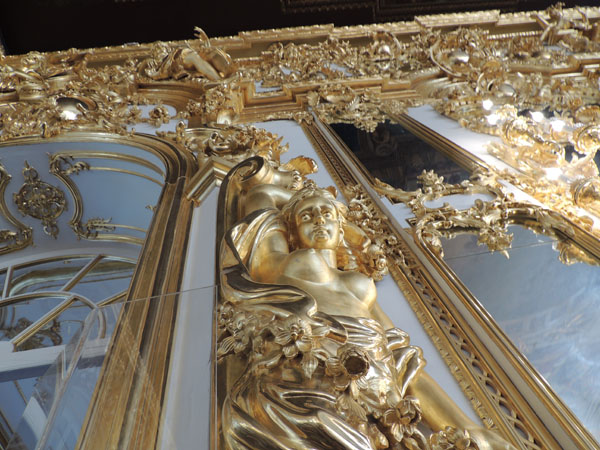
Way too much gold at the Catherine Palace.
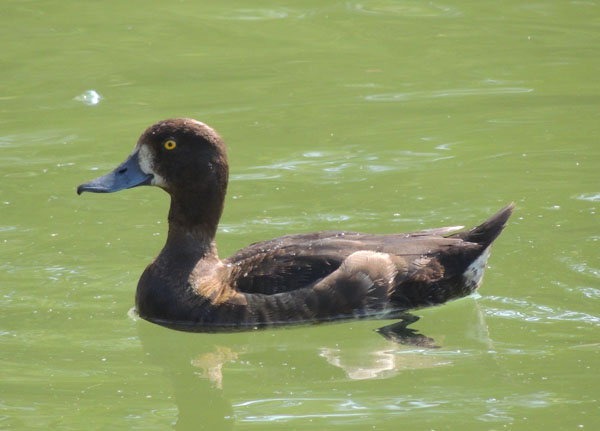
Some sort of European duck at a pond at the Catherine Palace, perhaps a pochard.
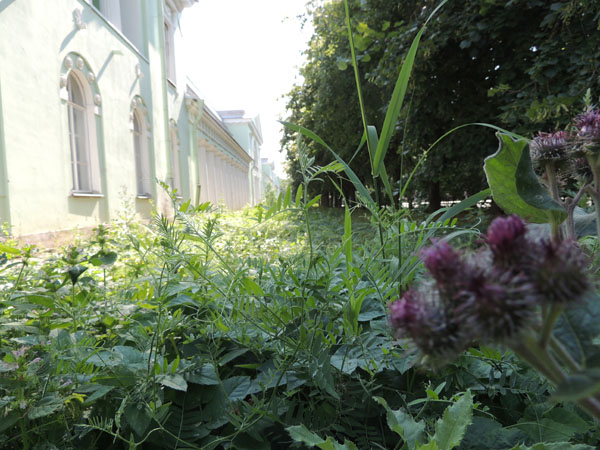
Weeds and wildflowers near the Catherine Palace.
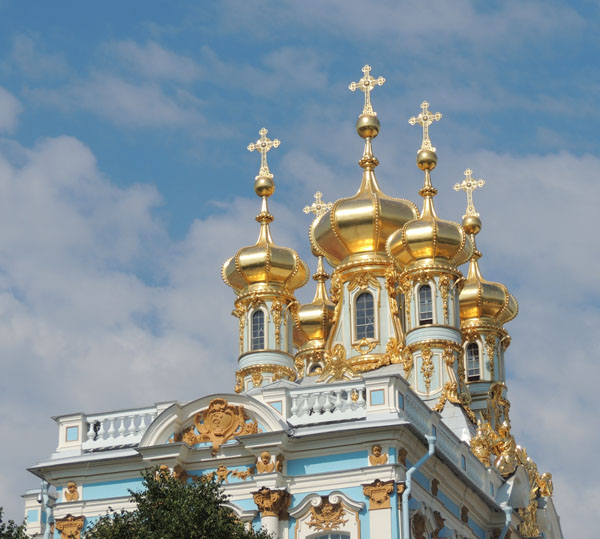
The golden towers of the chapel within the Catherine Palace. All that gold and that arrangement of domes is necessary to tune in God.
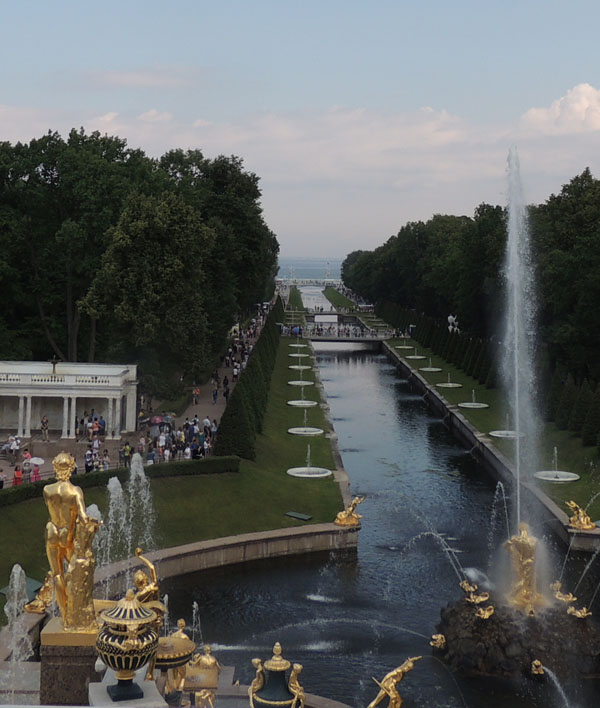
The Samson Fountains and canal to the Gulf of Finland at Peterhof Palace. Click to enlarge and see the ridiculous gilded statues.
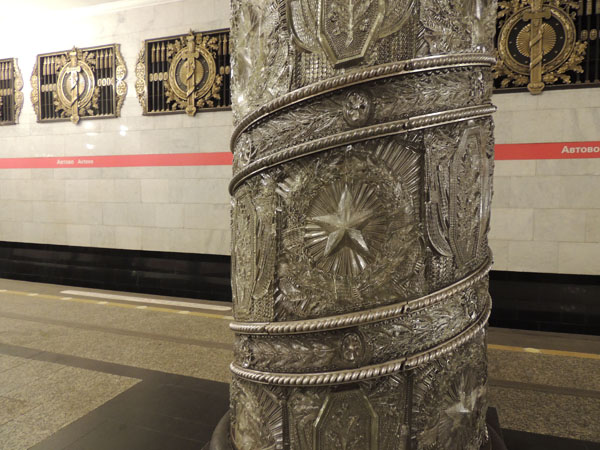
Inside the beautiful St. Petersburg Metro. Click to enlarge.
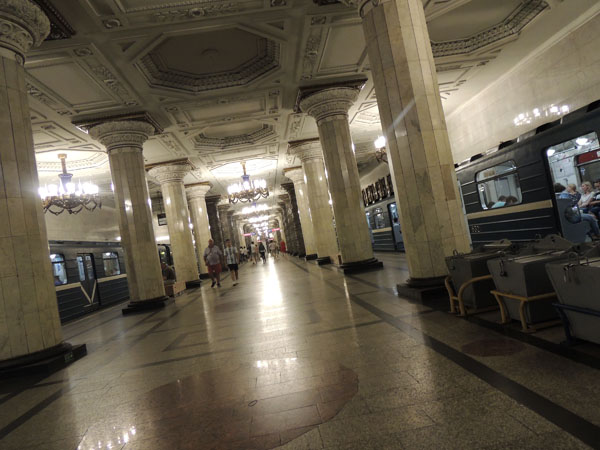
More of inside the beautiful St. Petersburg Metro. Click to enlarge.
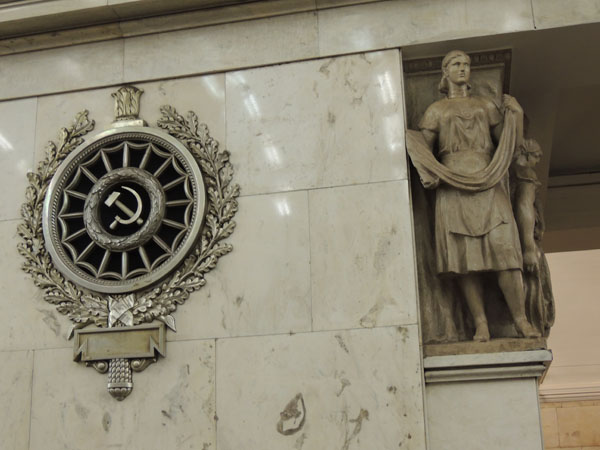
A refreshing hammer & sickle in the St. Petersburg Metro.
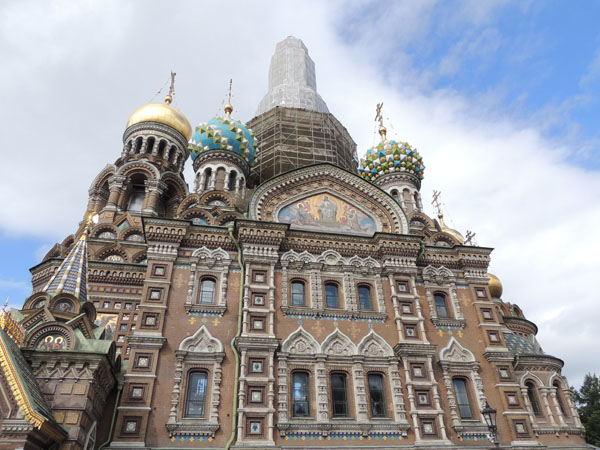
Outside the Church of the Spilled Blood. Click to enlarge.
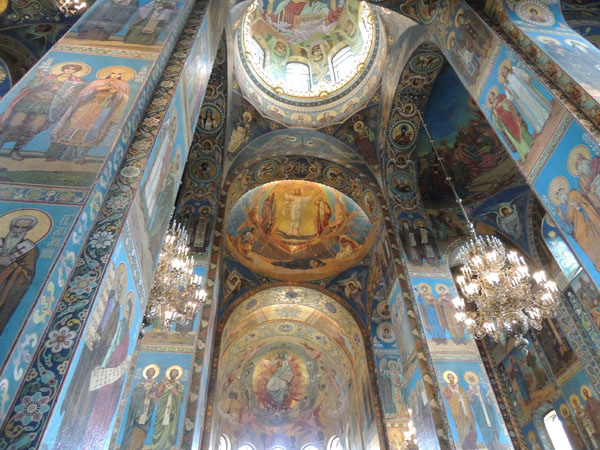
The lavish interior the Church of the Spilled Blood. Click to enlarge.
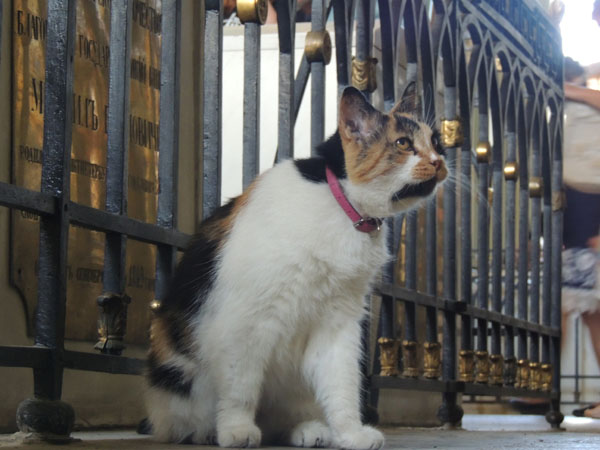
The St. Petersburg Cathedral's cat-in-residence. Supposedly she recently had a litter of kittens.
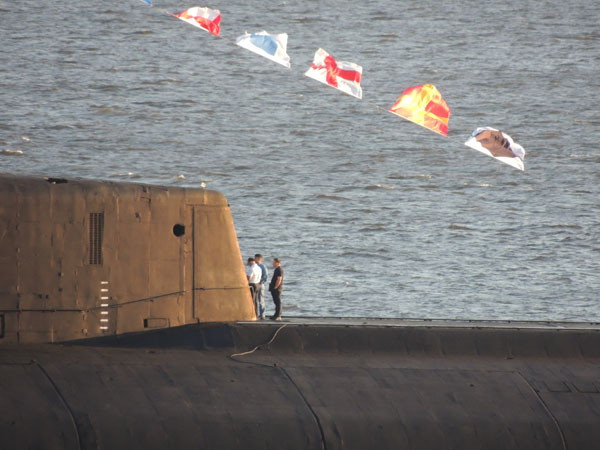
Men on a Russian submarine. Not to stereotype, but they're probably drinking vodka.
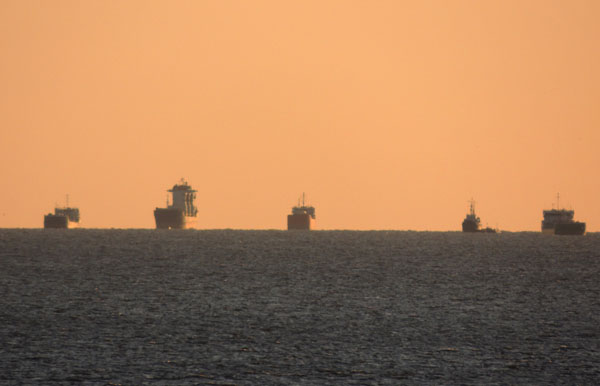
Boats on the horizon in the Gulf of Finland, looking west.
For linking purposes this article's URL is:
http://asecular.com/blog.php?190728 feedback
previous | next |












